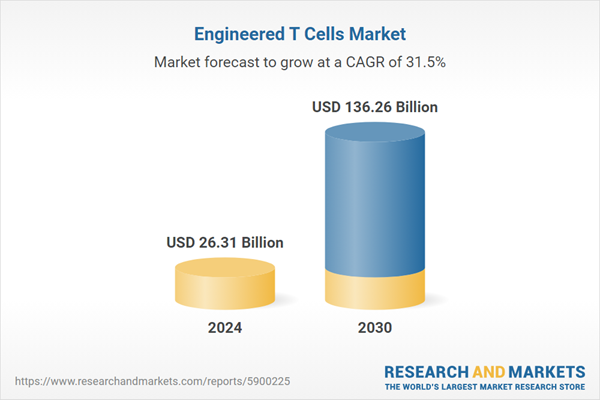Free Webex Call
The Engineered T Cells Market was valued at USD 26.31 Billion in 2024, and is expected to reach USD 136.26 Billion by 2030, rising at a CAGR of 31.51%. This growth is primarily driven by rapid advancements in cellular immunotherapy and the increasing adoption of engineered T cell therapies in oncology. Speak directly to the analyst to clarify any post sales queries you may have.
10% Free customizationThis report comes with 10% free customization, enabling you to add data that meets your specific business needs.
Engineered T cell therapies - particularly Chimeric Antigen Receptor T cells (CAR-T) and T Cell Receptor T cells (TCR-T) - have transformed cancer treatment by leveraging the body’s immune system to identify and destroy malignant cells. Ongoing progress in synthetic biology and gene editing has significantly improved the safety, efficacy, and persistence of these therapies, positioning them as a promising solution for both hematologic malignancies and solid tumors.
Regulatory agencies are accelerating the approval processes and broadening indications for these therapies, prompting substantial investments from biotechnology and pharmaceutical companies in research and development. These investments aim to optimize therapeutic design, enhance manufacturing efficiency, and expand the clinical applications of engineered T cells. Market growth is further supported by increasing patient awareness, higher healthcare spending, and strengthening collaborations between academic institutions and industry stakeholders to foster innovation.
Key Market Drivers
Advancements in Immunotherapy Research
Immunotherapy has emerged as a transformative approach in modern medicine, particularly in the treatment of cancer. Engineered T cell therapies, such as CAR-T and TCR-T, have gained significant traction due to their ability to utilize the immune system for targeted therapeutic interventions. These innovations stem from a deeper understanding of immune system mechanisms, enabling the development of highly specialized treatments.For example, CAR-T cell therapy involves modifying a patient’s own T cells to recognize and destroy cancer cells. Since the first CAR-T therapy received regulatory approval in 2017, over 30,000 patients with hematologic cancers have undergone treatment, with some achieving durable remissions lasting a decade or more.
Key Market Challenges
Manufacturing Complexity
The production of engineered T cell therapies is highly complex and requires rigorous quality control protocols. Ensuring T cell viability and functionality throughout the manufacturing process is essential for therapeutic success. Scaling up production to meet increasing demand poses significant challenges, as even minor variations in manufacturing conditions can affect product consistency and treatment outcomes.Key Market Trends
Expansion into Solid Tumors
While CAR-T therapies have primarily been used to treat hematologic cancers, research is increasingly directed toward expanding their use in solid tumors. Emerging clinical trials are focused on overcoming the unique biological barriers presented by solid tumors, potentially broadening the therapeutic scope of engineered T cells and extending their benefits to a wider patient population.Key Market Players
- Amgen Inc
- Athenex, Inc.
- Bellicum Pharmaceuticals Inc
- Bristol-Myers Squibb Co
- Eli Lilly & Co
- Gilead Sciences Inc
- Novartis AG
- Oxford Biomedica PLC
- Pfizer Inc
- Precision BioSciences Inc
Report Scope:
In this report, the Global Engineered T Cells Market has been segmented into the following categories, in addition to the industry trends which have also been detailed below:Engineered T Cells Market, By Type:
- Chimeric Antigen Receptor
- T Cell Receptor
- Tumor-Infiltrating Lymphocytes
Engineered T Cells Market, By Application:
- Breast Cancer
- Colorectal Cancer
- Leukemia
- Lung Cancer
- Melanoma
Engineered T Cells Market, By End-User:
- Cancer Research Centers
- Clinics
- Hospitals
- Others
Engineered T Cells Market, By Region:
- North America
- United States
- Canada
- Mexico
- Europe
- Germany
- United Kingdom
- France
- Italy
- Spain
- Asia-Pacific
- China
- Japan
- India
- Australia
- South Korea
- South America
- Brazil
- Argentina
- Colombia
- Middle East & Africa
- South Africa
- Saudi Arabia
- UAE
Competitive Landscape
Company Profiles: Detailed analysis of the major companies present in the Global Engineered T Cells Market.Available Customizations:
With the given market data, the publisher offers customizations according to a company's specific needs. The following customization options are available for the report.Company Information
- Detailed analysis and profiling of additional market players (up to five).
This product will be delivered within 1-3 business days.
Table of Contents
1. Product Overview
2. Research Methodology
3. Executive Summary
5. Global Engineered T Cells Market Outlook
6. North America Engineered T Cells Market Outlook
7. Europe Engineered T Cells Market Outlook
8. Asia-Pacific Engineered T Cells Market Outlook
9. South America Engineered T Cells Market Outlook
10. Middle East and Africa Engineered T Cells Market Outlook
11. Market Dynamics
12. Market Trends & Developments
13. Porter’s Five Forces Analysis
14. Competitive Landscape
Companies Mentioned
- Amgen Inc
- Athenex, Inc.
- Bellicum Pharmaceuticals Inc
- Bristol-Myers Squibb Co
- Eli Lilly & Co
- Gilead Sciences Inc
- Novartis AG
- Oxford Biomedica PLC
- Pfizer Inc
- Precision BioSciences Inc
Table Information
| Report Attribute | Details |
|---|---|
| No. of Pages | 181 |
| Published | April 2025 |
| Forecast Period | 2024 - 2030 |
| Estimated Market Value ( USD | $ 26.31 Billion |
| Forecasted Market Value ( USD | $ 136.26 Billion |
| Compound Annual Growth Rate | 31.5% |
| Regions Covered | Global |
| No. of Companies Mentioned | 10 |









